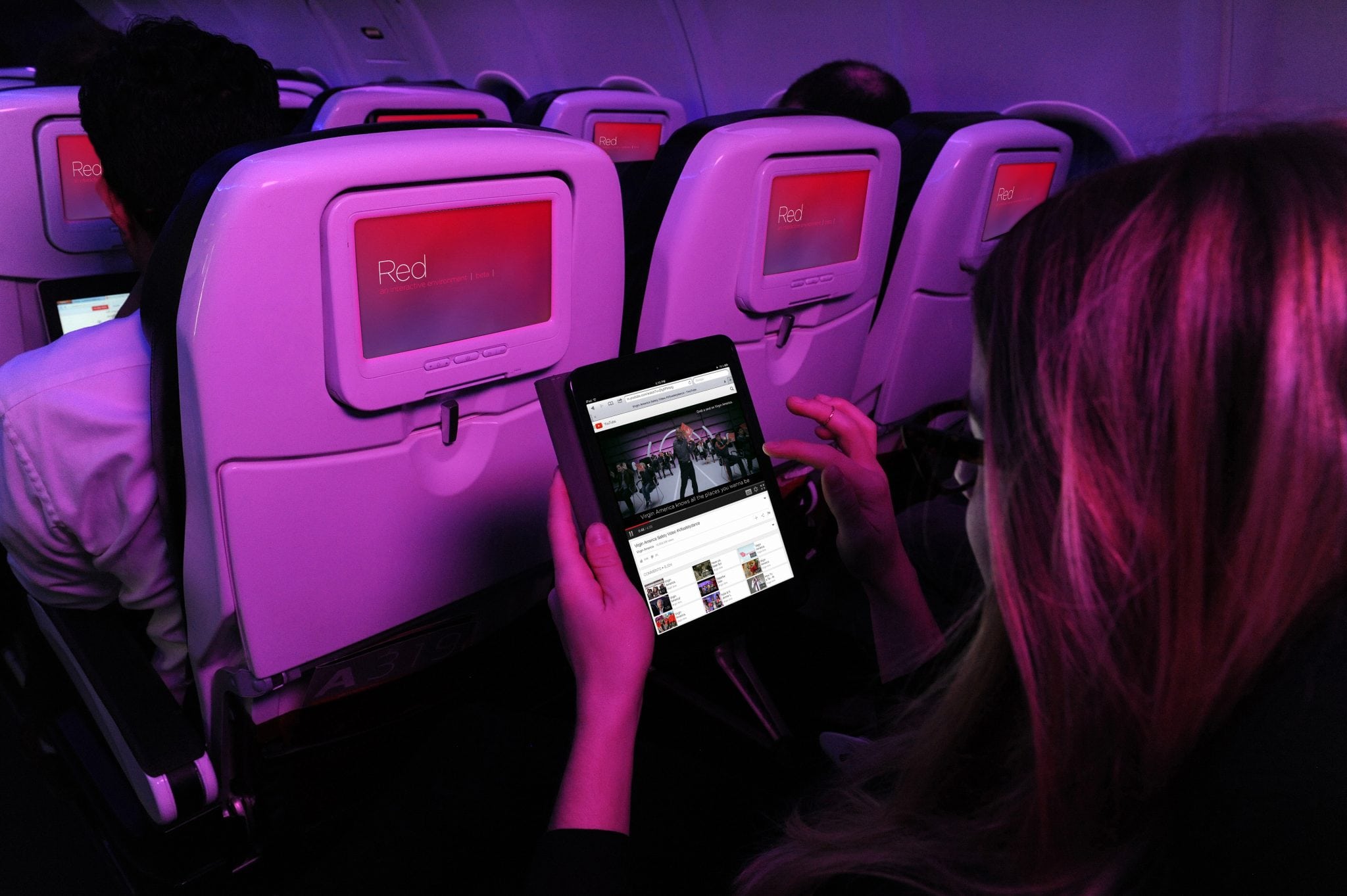[Avionics Today 07-22-2015] Virgin America announced earlier this month that it will use ViaSat’s hybrid Ka/Ku solution to deliver In-Flight Connectivity (IFC) on its next 10 deliveries of A320s in a move that may be a harbinger for hybrid connectivity solutions everywhere. With the airline’s fleet already fully equipped with Gogo’s Air-to-Ground (ATG) solution, ATG 4, the move to ViaSat for a satellite solution will help equip aircraft flying its Hawaii routes for faster IFC as of 2016.
 |
| Virgin America passenger using the in-flight Wi-Fi. Photo: Virgin America |
“We do believe that satellite Wi-Fi is the future and will help us keep pace with how people use the Internet today,” Ken Bieler, director of product design and innovation at Virgin America, told Avionics Magazine. “Every year travelers use more and more bandwidth and this new partnership opens up a new world of bandwidth options for guests, including the ability to stream video content in-flight.”
The Ka-band connectivity offered through ViaSat’s technology and delivered through its ViaSat 1 High Throughput Satellite (HTS) promises speeds of up to 140 gigabits per second, touted as eight to 10 times faster than any other in-flight Wi-Fi system — presumably including Gogo’s ATG 4. Furthermore, ViaSat’s satellite-based connectivity offers a path to providing IFC to the airline’s oceanic routes, specifically in light of Virgin America’s plans to expand routes to Hawaii.
“ViaSat offered a Wi-Fi connectivity roadmap that would allow us to soon offer Wi-Fi service over the Pacific,” said Beiler. He also noted that the airline will continue to use ATG 4 on its current fleet of 53 aircraft but has “not yet made a technology decision in terms of future state of connectivity for these aircraft.”
This may not be an enormous contract loss for Gogo, which is in the process of launching its own satellite solution, 2Ku, with service slated to begin by the end of this year. However, it does send waves into the IFC market as the pool of un-equipped North American airlines runs dry and connectivity providers begin to butt heads over international competition.
“The most significant part of this announcement is that this represents the first instance of a carrier moving to a new connectivity provider that we are aware of,” explained Andrew Spinola, senior analyst at Wells Fargo, in a statement following the announcement underpinning that churn and contract losses are expected in any and every business. However, he makes note that the win is potentially big for ViaSat’s Ka/Ku antenna.
The hybrid antenna isn’t new and has been in development with ViaSat since 2007, but Don Buchman, vice president and general manager of commercial mobility business at ViaSat, notes that the market demand was relatively weak. The solution was originally developed with military and business aircraft applications in mind. In 2014, market interest and demand began to increase from government, general aviation, and commercial airline customers and in July 2014, ViaSat conducted two airborne trials of the hybrid antenna on a Boeing 757 across three different satellite networks, connecting with six Ka- and Ku-band satellites. With Virgin America signing on as the first commercial airline to operate in both Ku- and Ka-band satellite networks — with installation to begin immediately — it’s likely other commercial operators will also begin to equip with a hybrid solution.
“This is a meaningful win for ViaSat because it is the first commercial win with the Ka/Ku solution, which was initially developed for the U.S. govt.,” Spinola explained. “ViaSat has been primarily considered a regional provider of aviation broadband within its Viasat 1 North American footprint, but the viability of the Ka/Ku solution makes ViaSat a contender outside of North America.”
While Buchman admits that the Ku solution may currently be somewhat immature, as with cell phone connectivity, customers are looking for ways to connect in every corner of the globe.
“Virgin America was looking to expand their flight routes from the lower 48 to Hawaii, which seemed to match the Ku/Ka antenna product we were developing,” he said. “Today, many airlines have aircraft flying in these oceanic routes where the faster service isn’t there yet, but they still want connectivity for it. Typical aircraft miles may only represent 10 percent of an airline’s fleet, but they still want to connect them. This is where our Ku/Ka antenna kicks in.”
ViaSat is in the process of extending its Ka-band footprint worldwide, according to Buchman, with an additional satellite, ViaSat 2, which is slated for launch toward the second half of 2016 and will enter service in 2017. The company today has a footprint in Europe and the U.S., but the new satellite will extend ViaSat’s Ka-band coverage through Mexico, the Caribbean and out to the southern tip of South America. It also covers Canada and the North Atlantic Tracks where it connects with the satellite provider’s European partner, Eutelsat. This may hedge in on some of the international business Gogo has set its sights on with its upcoming 2Ku capability.
Despite the possible impending commercial success of the Ku/Ka antenna in North America, Buchman is focusing on the global connectivity ahead.
“For us, the antenna technology is secondary,” said Buchman. “We think there’s demand for connectivity whether it be from the airline or the aircraft itself. That demand is going to increase and what people want is connectivity with the right speeds to make the connectivity work, as well as the economics. When our next satellite launches in 2016 that will expand the footprint. If we go around the globe, then the antenna technologies need to follow.”